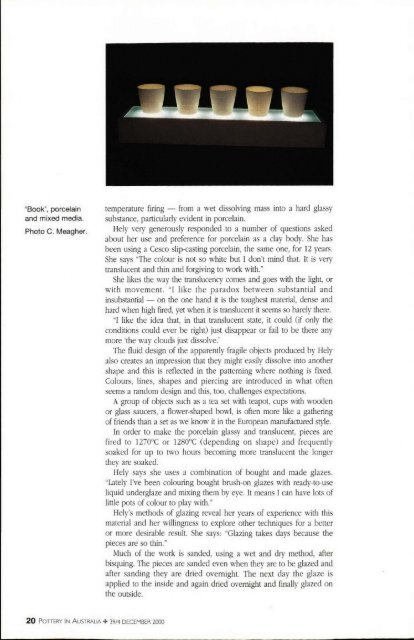Pottery In Australia Vol 39 No 4 December 2000
You also want an ePaper? Increase the reach of your titles
YUMPU automatically turns print PDFs into web optimized ePapers that Google loves.
'Book', porcelain<br />
and mixed media.<br />
Photo C. Meagher.<br />
temperature firing - from a wet dissolving mass into a hard glassy<br />
substance, particularly evident in porcelain.<br />
Hely very generously responded to a number of questions asked<br />
about her use and preference for porcelain as a clay body. She has<br />
been using a Cesco slip-casting porcelain, the same one, for 12 years.<br />
She says "The colour is not so white but [ don't mind that. It is very<br />
translucent and thin and forgiving to work with."<br />
She likes the way the translucency comes and goes with the light, or<br />
with movement. "[ like the paradox between substantial and<br />
insubstantial - on the one hand it is the toughest material, dense and<br />
hard when high fired, yet when it is translucent it seems so barely there.<br />
"[ like the idea that, in that translucent state, it could (if only the<br />
conditions could ever be right) just disappear or fail to be there any<br />
more 'the way clouds just dissolve.'<br />
The fluid design of the apparently fragile objects produced by Hely<br />
also creates an impression that they might easily dissolve into another<br />
shape and this is reflected in the patterning where nothing is fixed.<br />
Colours, lines, shapes and piercing are introduced in what often<br />
seems a random design and this, too, challenges expectations.<br />
A group of objects such as a tea set with teapot, cups with wooden<br />
or glass saucers, a flower-shaped bowl, is often more like a gathering<br />
of friends than a set as we know it in the European manufactured style.<br />
<strong>In</strong> order to make the porcelain glassy and translucent, pieces are<br />
fired to 1270°C or 1280°C (depending on shape) and frequen tl y<br />
soaked for up to two hours becoming more translucent the longer<br />
they are soaked.<br />
Hely says she uses a combination of bought and made glazes.<br />
"Lately I've been colouring bought brush-on glazes with ready-to-use<br />
liqUid underglaze and mixing them by eye. It means I can have lots of<br />
little pots of colour to play with."<br />
Hely's methods of glazing reveal her years of experience witl] this<br />
material and her willingness to explore other techniques for a better<br />
or more desirable result. She says: "Glazing takes days because the<br />
pieces are so thin."<br />
Much of the work is sanded, using a wet and dry method, after<br />
bisquing. The pieces are sanded even when they are to be glazed and<br />
after sanding they are dried overnight. The next day the glaze is<br />
applied to the inside and again dried overnight and finally glazed on<br />
the outside.<br />
20 POTIERY IN A USTRAUA + <strong>39</strong>14 DECEMBER <strong>2000</strong>


















